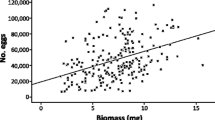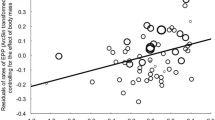Abstract
We have investigated the influence of Microphallus papillorobustus (Trematoda) on the reproductive biology and mating patterns of its intermediate host Gammarus insensibilis (Amphipoda). Infected Gammarus species show altered behaviour which renders them more susceptible to predation by Charadriiform birds, the parasite's definitive hosts. In a natural population of G. insensibilis, mean parasite intensity was higher for unpaired individuals than for paired individuals. Fecundity was reduced in infected amphipods. Size-assortative pairing was significant, although infected males were found with smaller females compared to uninfected males of the same size. There was also a positive assortative pairing by parasitic prevalence. Vertical segregation between infected and uninfected individuals, male-male competition for access to uninfected females, and female choice may explain assortative mating for prevalence. This study provides the first empirical evidence that parasites can have a direct effect on patterns of mating in gammarids.
Similar content being viewed by others
References
Adams J, Greenwood PJ (1983) Why are males bigger than females in pre-copula pairs of Gammarus pulex? Behav Ecol Sociobiol 13: 239–241
Adams J, Greenwood PJ (1987) Loading constraints, sexual selection and assortative mating in peracarid Crustacea. J Zool Lond 211: 35–46
Baudouin M (1975) Host castration as a parasitic strategy. Evolution 29: 335–352
Birkhead TR, Clarkson K (1980) Mate selection and precopulatory guarding in Gammarus pulex. Z Tierpsychol 52: 365–380
Borgia G (1986) Satin bowerbird parasites: a test of the bright male hypothesis. Behav Ecol Sociobiol 19: 355–358
Borgia G, Collis K (1989) Female choice for parasite-free male satin bowerbirds and the evolution of bright male plumage. Behav Ecol Sociobiol 25: 445–454
Brown AF, Pascoe D (1989) Parasitism and host sensitivity to cadmium: an acantocephalan infection of the freshwater amphipod Gammarus pulex. J Appl Ecol 26: 473–487
Brun B (1971) Variations intraspécifiques et spéciation chez deux espèces de gammares d'eau saumâtre du groupe Gammarus locusta (Crustacés, Amphipodes). Doctoral thesis, Université de Provence, Marseille
Crespi BJ (1989) Causes of assortative mating in arthropods. Anim Behav 38: 980–1000
Elwood R, Gibson J, Neil S (1987) The amorous Gammarus: size assortative mating in G. pulex. Anim Behav 35: 1–6
Festa-Bianchet M (1988) Nursing behaviour of bighorn sheep: correlates of ewe age, parasitism, lamb age, birthdate and sex. Anim Behav 36: 1445–1454
Forbes MRL (1991) Ectoparasites and mating success of male Enallagma ebrium damselflies (Odonata: Coenagrionidae). Oikos 60: 336–342
Greenwood PJ, Adams J (1984) Sexual dimorphism in Gammarus pulex: the effect of current flow on pre-copula pair formation. Freshwat Biol 14: 203–209
Hamilton WD, Zuk M (1982) Heritable true fitness and bright birds: a role for parasites. Science 218: 384–387
Hartnoll RG, Smith SM (1978) Pair formation and the reproductive cycle in Gammarus duebeni. J Nat Hist 12: 501–511
Helluy S (1983) Un mode de favorisation de la transmission parasitaire: la manipulation du comportement de l'hôte intermédiaire. Rev Ecol Terre Vie 38: 211–223
Helluy S (1984) Relations hôtes-parasites du trématode Microphallus papillorobustus (Rankin, 1940). III Facteurs impliqués dans les modifications du comportement des Gammarus hôtes intermédiaires et tests de predation. Ann Parasitol Hum Comp 59: 41–56
Houde AE, Torio AJ (1992) Effect of parasitic infection on male color pattern and female choice in guppies. Behav Ecol 3: 346–351
Howard RD, Minchella DJ (1990) Parasitism and mate competition. Oikos 58: 120–122
Hynes HBN (1954) The ecology of Gammarus duebeni Lilljeborg and its occurrence in freshwater in western Britain. J Anim Ecol 23: 38–84
Hynes HBN (1955) The reproductive cycle of some British freshwater Gammaridae. J Anim Ecol 24: 352–387
Kusano H, Kusano T (1989) Size assortative mating and sexual dimorphism in gammaridean Amphipoda. Jap J Ecol 39: 147–161
Margolis L, Esch GW, Holmes JC, Kuris AM, Schad GA (1982) The use of ecological terms in parasitology (report of an ad hoc committee of the American Society of Parasitologists). J Parasitol 68: 131–133
Minchella DJ, Scott ME (1991) Parasitism: a cryptic determinant of animal community structure. Trends Ecol Evol 6: 250–254
Møller AP (1990) Parasites and sexual selection: current status of the Hamilton and Zuk hypothesis. J Evol Biol 3: 319–328
Moore JK (1981) The ecology of the acanthocephalan (Plagiorhynchus cylindraceus) in the isopod (Armadillidium vulgare) and the starling (Sturnus vulgaris). PhD thesis, University of New-Mexico, Albuquerque
Poulton MJ, Thompson DJ (1987) The effects of the acanthocephalan parasite Pomphorhynchus laevis on mate choice in Gammarus pulex. Anim Behav 35: 1577–1578
Pringle S (1982) Factors affecting the microdistribution of different sizes of the amphipod Gammarus pulex. Oikos 38: 369–373
Reinhard EG (1956) Parasitic castration of Crustacea. Exp Parasitol 5: 79–107
Rumpus AE, Kennedy CR (1974) The effect of the acanthocephalan Pomphorhynchus laevis upon the respiration of its intermediate host, Gammarus pulex. Parasitology 68: 271–284
Schall JJ, Dearing MD (1987) Malarial parasitism and male competition for mates in the western fence lizard, Sceloporus occidentalis. Oecologia 73: 389–392
Siegel S, Castellan NJ (1988) Nonparametric statistics for the behavioural sciences, 2nd edn. McGraw-Hill, New York
Sokal RR, Rohlf FJ (1981) Biometry, 2nd edn. Freeman, New York
Stark GTC (1965) Diplocotyle (Eucestoda), a parasite of Gammarus zaddachi in the estuary of the Yorkshire Esk, Britain. Parasitology 55: 415–420
Sutcliffe DW (1992) Reproduction in Gammarus (Crustacea: Amphipoda): basic reproductive processes. Freshwat Forum 2: 102–128
Sutcliffe DW (1993) Reproduction in Gammarus (Crustacea: Amphipoda): male strategies. Freshwat Forum 3: 97–109
Thompson DJ, Moule SJ (1983) Substrate selection and assortative mating in G. pulex. Hydrobiologia 99: 3–6
Ward PI (1983) Advantages and a disadvantage of large size for male Gammarus pulex (Crustacea Amphipoda). Behav Ecol Sociobiol 14: 69–76
Ward PI (1984) The effects of size on the mating decisions of Gammarus pulex (Crustacea Amphipoda). Z Tierpsychol 64: 174–184
Ward PI (1985) The breeding behaviour of Gammarus duebeni. Hydrobiologia 121: 45–50
Ward PI (1986) A comparative field study of the breeding behaviour of a stream and a pond population of Gammarus pulex (Amphipoda). Oikos 46: 29–36
Ward PI (1988) Sexual selection, natural selection and body size in Gammarus pulex (Amphipoda). Am Nat 131: 348–359
Ward PI, Porter AH (1993) The relative roles of habitat structure and male-male competition in the mating system of Gammarus pulex (Crustacea; Amphipoda): a simulation study. Anim Behav 45: 119–133
Zuk M (1987) The effects of gregarine parasites, body size, and time of day on spermatophore production and sexual selection in field crickets. Behav Ecol Sociobiol 21: 65–72
Author information
Authors and Affiliations
Rights and permissions
About this article
Cite this article
Thomas, F., Renaud, F., Derothe, J.M. et al. Assortative pairing in Gammarus insensibilis (Amphipoda) infected by a trematode parasite. Oecologia 104, 259–264 (1995). https://doi.org/10.1007/BF00328591
Received:
Accepted:
Issue Date:
DOI: https://doi.org/10.1007/BF00328591




